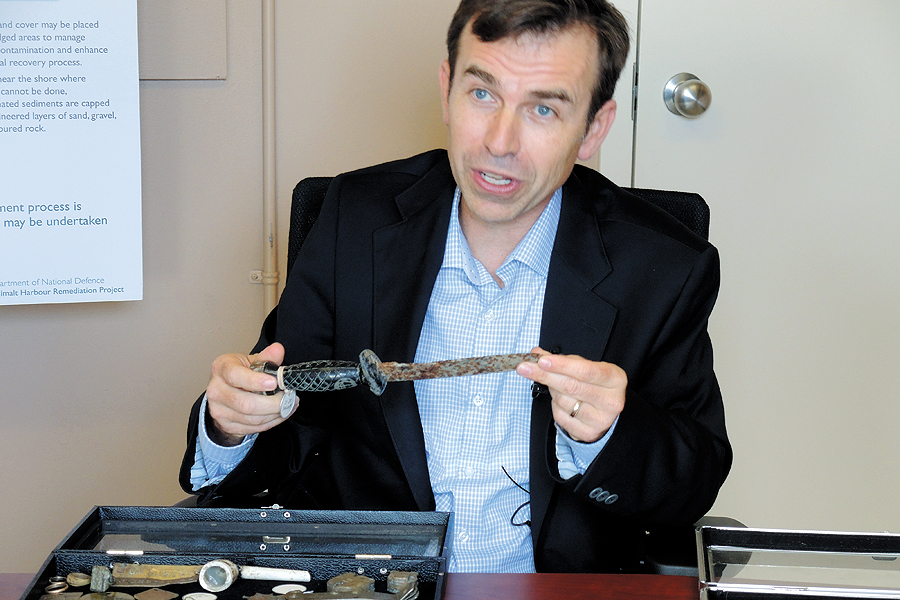Unintended time capsule revealed in mud
By Lookout on Oct 31, 2016 with Comments 1

Duane Freeman, a senior environmental officer at CFB Esquimalt, displays a diver’s knife found during dredging operations in Esquimalt Harbour.
Peter Mallett, Staff Writer ~
A massive cleanup of Esquimalt Harbour’s seabed continues to reveal a cache of historical artifacts.
The multi-year $160-million Esquimalt Harbour Remediation Project began in late 2015 and involves removing contaminated silt from the seabed, created by over 150 years of commercial and naval operations within the harbour. The purpose of the remediation is to clean up the historical contamination from various areas of the harbour, with an end goal of improving the overall health of marine species in the area.
As the massive dredging operation, covering 354 hectares, continues, employees from Formation Safety and Environment (FSE) have been taken aback by the diversity of items found locked in the thick layer muck.
“We were completely caught by surprise and did not expect this,” said Duane Freeman, who is the Branch Head in charge of FSE.
Two large display cases at FSE house service medals, uniform buttons, straight edge razors, rings, cigarette lighters, plates, cutlery, and several IDs. Not on display were the remains of hundreds of boots. There is no exact count of the number of items recovered, but most date from the 1980s back to the turn of the century, says Freeman.
One of the first discoveries was a coffee mug that belonged to VAdm (Ret’d) Gary Garnett almost 30 years ago when he was Commander of the Second Canadian Destroyer Squadron. His name and squadron of his ship were still visible on the mug.
Freeman says the cold water temperatures and layers of accumulating silt have helped to preserve many of the found items. To expand on his point he displays a military identification card noting the card was likely from the mid-1950s and belonged to Norman John Boulton of HMCS Cornwallis, whose name and picture are still legible.
The dredging operation was carried out by a giant crane barge. The large crane equipped with a bucket was guided by GPS technology and scoops out every square-metre of designated area on the chart, and then places it onto the deck of another barge.
Before disposal, a machine sorted artifacts from the muck and then workers sorted through the contents.
“We had no idea we were going to end up with all of these artifacts, but now the question is what do we do with them? What comes next?” says Freeman.
Ideas include a travelling display or a permanent one somewhere on the base.
While the items are of historical interest they also reveal attitudes of the time with regards to the environment.
“It speaks to a different time when it was normal for sailors to throw things off the ship; throwing them over the side was just an expedient way to get rid of things,” says Freeman pointing to the mounting pile of boots and soles recovered.
“Littering is something of the past. Today and sailors have an active solid waste management program and policies that prevent this type of behaviour.”
Freeman said the shift in mindset about the harbour’s environmental health began in the early 1990s. A 1992 study on Esquimalt Harbour revealed contamination through 25 chemicals including PCBs and metals – arsenic, mercury, lead, cadmium.
The Esquimalt Harbour Remediation Project is part of a 15-year Federal Contaminated Sites Action Plan established in 2005 to address federal contaminated sites presenting the highest health and ecological risks.
The Department of National Defence is currently remediating the seabed in areas adjacent to A, B, C and Y Jetties, ML Floats, and contaminated areas of Lang Cove. Future remediation projects will address additional contaminated sea beds near D, F and G Jetty, along with recent cleanup by Public Services and Procurement Canada adjacent to the Esquimalt Graving Dock.
The remediation project is concurrent with DND’s A/B Jetty Recapitalization Project, an effort to replace the nearly 70-year-old jetties with structurally sound, larger, and more versatile berthing facilities.

Formation Safety and Environment staff are researching details about several items found during dredging operations, including several discarded service medals like the one displayed (middle), and engraved straight edge razors used for shaving (right), along with several IDs, rings, cigarette lighters, plates, and cutlery.
Filed Under: Top Stories
About the Author:






Extraordinary and interesting.